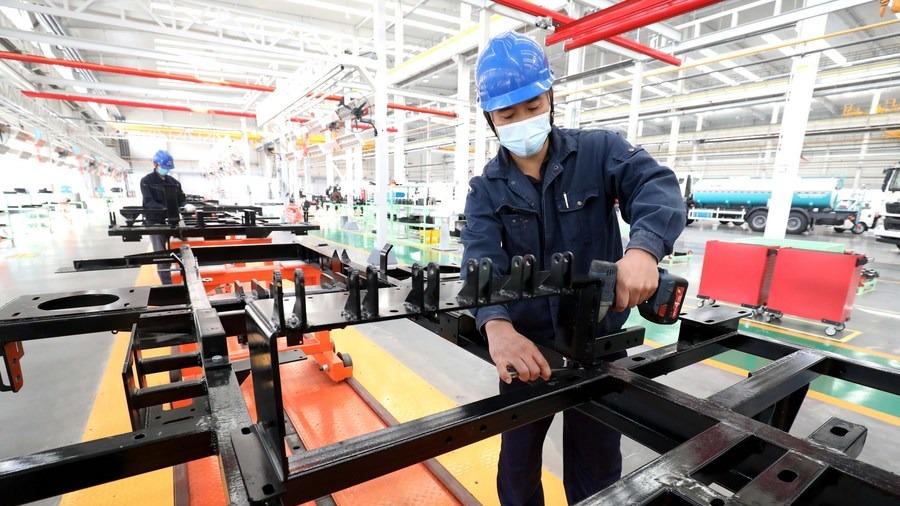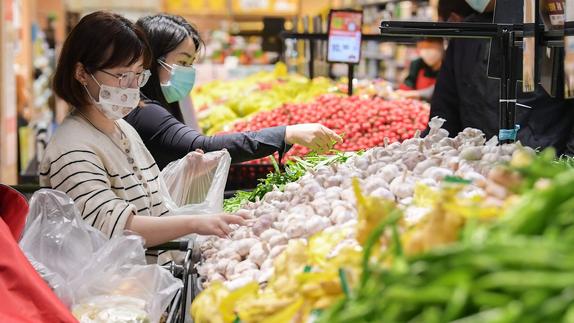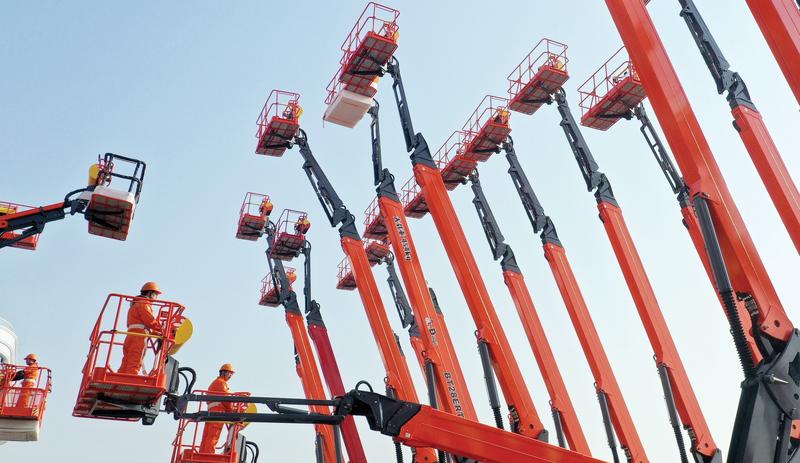 In this Oct 19, 2020 photo, workers are busy at the factory of a manufacturing company in Shijiazhuang, north China's Hebei Province. (LIANG ZIDONG / XINHUA)
In this Oct 19, 2020 photo, workers are busy at the factory of a manufacturing company in Shijiazhuang, north China's Hebei Province. (LIANG ZIDONG / XINHUA)
BEIJING - China's value-added industrial output, an important economic indicator, went up 4 percent year-on-year in the first four months of this year, data from the National Bureau of Statistics showed Monday.
The figure was 2.5 percentage points lower than that in the January-March period, the NBS said.
Pressures such as insufficient market demand, impeded industrial and supply chains, as well as higher production costs are weighing on the industrial sector at present, NBS spokesperson Fu Linghui said, reiterating that the country's complete industrial system and strong supporting capacity have remained unchanged
In April alone, industrial output declined 2.9 percent year-on-year from the previous month, according to the NBS.
During the January-April period, mining output recorded year-on-year growth of 10.4 percent, the fastest among the three major industrial sectors.
The output of the manufacturing sector increased by 3.2 percent, while the production and supply of electricity, heat, gas and water rose by 5 percent, according to the NBS.
The high-tech manufacturing sector posted stellar performance in the period, with the value-added output surging 11.5 percent year-on-year.
In terms of production, the output of new energy vehicles logged a marked increase of 112.7 percent, while that of solar batteries and mobile communication base stations jumped 27.5 percent and 25.9 percent year-on-year, respectively.
Pressures such as insufficient market demand, impeded industrial and supply chains, as well as higher production costs are weighing on the industrial sector at present, NBS spokesperson Fu Linghui said, reiterating that the country's complete industrial system and strong supporting capacity have remained unchanged.
With efforts to contain the COVID-19 pandemic, enhance transportation and logistics and support enterprises to tide over difficulties, industrial production will be on the mend, Fu added.
The industrial output is used to measure the activity of designated large enterprises with an annual business turnover of at least 20 million yuan ($2.95 million).
 Residents shop at a supermarket in Songjiang district of Shanghai, on May 10, 2022. (PHOTO / XINHUA)
Residents shop at a supermarket in Songjiang district of Shanghai, on May 10, 2022. (PHOTO / XINHUA)
Retail sales drop
China's retail sales declined during the first four months of this year as the flare-ups of COVID-19 weighed on the country's consumer market, NBS data showed.
Retail sales of consumer goods, a significant indicator of China's consumption strength, went down 0.2 percent year-on-year to 13.81 trillion yuan ($2 trillion) in the January-April period, according to the data.
In April alone, retail sales declined 11.1 percent from a year ago to 2.95 trillion yuan.
"The decline of retail sales in April was mainly due to the short-term impact of COVID-19," said NBS' Fu at a press conference.
Moreover, China's online consumption continued to shore up retail sales. In the first four months, online sales of physical goods rose 5.2 percent, with its proportion in retail sales increasing
Last month, sales of non-daily necessities and the catering sector took a blow from the COVID-19 resurgence, dragging down the growth of China's overall retail sales, Fu said.
In April, catering revenues declined by 22.7 percent. Regions severely hit by COVID-19, such as the Yangtze River Delta and northeast China, saw retail sales plunge.
Despite the drop in retail sales, residents' basic living needs were guaranteed, leading to the sales growth of relevant commodities.
Sales of beverages of major enterprises jumped 6 percent in April, while sales of grain, edible oil and other food products rose 10 percent, NBS data showed.
Major supermarkets saw sales grow 3.6 percent year-on-year in the first four months. Sales from groceries and convenience stores rose 2.4 percent and 6.8 percent, respectively.
Moreover, China's online consumption continued to shore up retail sales. In the first four months, online sales of physical goods rose 5.2 percent, with its proportion in retail sales increasing.
Fu expected China's consumption to gradually recover from the COVID-19 impact and continue to stabilize the economy, adding that consumption served as the primary force driving China's economic growth in 2021 and the first quarter of this year.
"The pent-up consumption will be gradually released with the epidemic brought under control and production and people's lives returning to normal," Fu noted.
The recovery momentum of China's consumption will continue partly due to the easing epidemic situation, pro-consumption policies, and measures on supporting enterprises, he said.
ALSO READ: China strives to bring economy back on track amid COVID-19
 This undated file photo shows orkers at the production line of a machinery manufacturing company in Huzhou, Zhejiang province. (XIE SHANGGUO / XINHUA)
This undated file photo shows orkers at the production line of a machinery manufacturing company in Huzhou, Zhejiang province. (XIE SHANGGUO / XINHUA)
The retail sales of consumer goods went down 0.2 percent year-on-year in the first four months of this year, the NBS said
Fixed-asset investment saw steady growth
Meanwhile, China's fixed-asset investment saw steady growth in the first four months of this year, official data showed Monday.
Fixed-asset investment jumped 6.8 percent from a year earlier to 15.35 trillion yuan ($2.26 trillion) in the first four months, the NBS said.
The growth slowed from a 9.3-percent increase registered in the first quarter. In April, fixed-asset investment edged down 0.82 percent from a month earlier.
From January to April, fixed-asset investment from the private sector increased 5.3 percent from a year earlier to 8.69 trillion yuan.
Despite the resurgence of COVID-19 infections, China's investment in infrastructure construction rose 6.5 percent year-on-year in the first four months of this year.
Investment into the high-tech manufacturing and high-tech services sectors saw notable growth, jumping 25.9 percent and 13.2 percent year-on-year in the period.
The healthcare and education sectors also saw investment rise 24.9 percent and 12.5 percent during the period.
Investment has traditionally been a key engine for growth. In the face of COVID-19 flare-ups and increasing downward pressure on the economy, China has underlined the role of effective investment to bolster growth.
READ MORE: China's economy posts steady growth in Q1
 Residential buildings in Yangpu district in Shanghai, on March 23, 2020. (PHOTO / SIPA)
Residential buildings in Yangpu district in Shanghai, on March 23, 2020. (PHOTO / SIPA)
From January to April, fixed-asset investment from the private sector increased 5.3 percent from a year earlier to 8.69 trillion yuan
Property investment down
The total property investment in the period stood at 3.92 trillion yuan ($578 billion), the NBS said.
Investment in residential buildings came in at 2.95 trillion yuan, down 2.1 percent year-on-year.
Commercial housing sales in terms of floor area totaled 397.68 million square meters in the first four months, down 20.9 percent year-on-year.
In terms of value, commercial housing sales fell 29.5 percent to 3.78 trillion yuan during the four-month period.
The property development climate index compiled by the NBS came in at 95.89 points in April.
China's financial authorities on Sunday said the lower limit for interest rates on first-home purchase loans will be cut.
The move aims to reinforce the principle that "housing is for living in, not for speculation," support better real estate policies based on local conditions, and promote the healthy development of the country's property market, according to the central bank.


